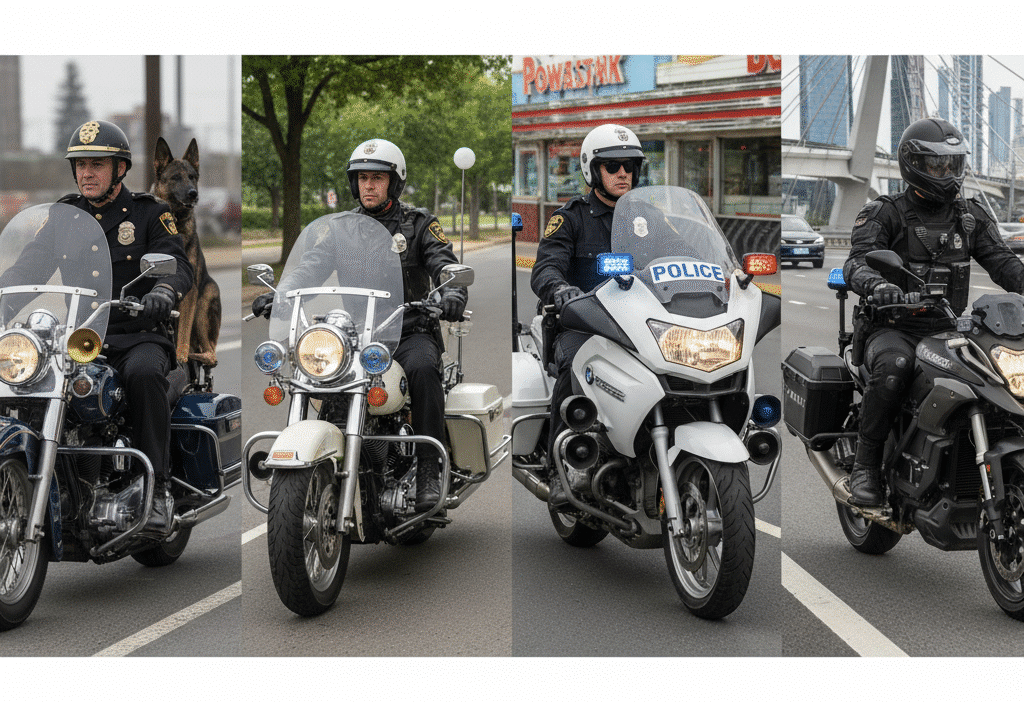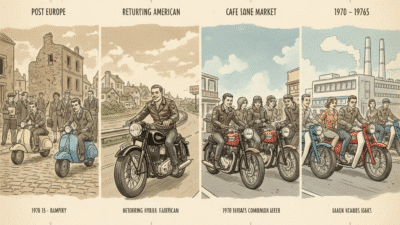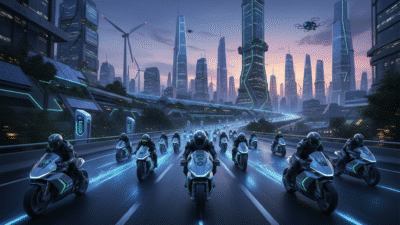From the very first sputtering engines to today’s high-tech, precision machines, the sight of a police motorcycle has always evoked a powerful sense of authority, agility, and unwavering presence. The journey of motorcycles in police forces over the decades is a thrilling saga of evolution, adaptation, and relentless dedication. These two-wheeled titans have gone from rudimentary machines used for simple patrols to indispensable tools for high-speed pursuits, intricate escort duties, and crucial community engagement. Their story is deeply interwoven with the history of modern policing, reflecting technological advancements, changing urban landscapes, and the enduring need for law enforcement to be swift, visible, and effective.
The Dawn of a New Era: Early Adoption and Essential Roles
Imagine the bustling streets of the early 20th century. Cars were still a novelty, and horse-drawn carriages reigned supreme. But a new form of locomotion was emerging, promising speed and maneuverability never before seen: the motorcycle. Police forces, ever on the lookout for an edge, quickly recognized its potential. Cities like Detroit, Michigan, and Evanston, Illinois, were among the first to experiment with motorcycle patrols as early as 1908. These initial bikes, often little more than motorized bicycles, were a revelation.
Suddenly, officers could cover vast distances far quicker than on foot or horseback. They could weave through traffic congestion that would stymie early automobiles. Their primary roles were often traffic control, responding to incidents, and serving as visible deterrents. Early models from brands like Harley-Davidson, Indian, and Excelsior became the workhorses, proving their ruggedness and reliability in the demanding environment of daily police work. This was a critical shift, as law enforcement began to move beyond fixed beats to a more mobile, responsive model. The agility offered by these early motorcycles even played a role in military applications, influencing their later use in police forces, as seen in the crucial contributions of motorcycles during World War I.

The Roaring Twenties and Beyond: Establishing an Icon
As the 20th century roared forward, so too did the motorcycle’s role in law enforcement. The 1920s and 30s saw these machines solidify their place. Prohibition-era crime waves and the rise of organized gangs highlighted the need for rapid response and pursuit capabilities. Motorcycles, with their ability to navigate tight city streets and quickly close distances, became invaluable. Their presence wasn’t just practical; it was symbolic. A police officer on a motorcycle commanded attention, embodying authority and swift justice.
Post-World War II, the iconic image of the police motor officer was firmly etched into public consciousness. Think of the formidable presence of a chrome-laden Harley-Davidson Electra Glide or an Indian Chief, ridden by an officer in full uniform, helmet gleaming. These bikes were not just for patrol; they excelled at ceremonial duties, leading parades, and providing escorts for dignitaries. The sheer presence of these machines, often equipped with sirens and flashing lights, made them a powerful symbol of order and public safety. The experience gained during wartime, where motorcycles in World War II played key roles and innovations, directly fed into improvements in civilian and police models, making them even more robust and capable.
Specialized Units Emerge
As urban centers grew, so did the complexity of traffic management. Police motorcycle units began to specialize, focusing on accident investigation, VIP escorts, and targeted traffic enforcement. Their ability to quickly reach accident scenes, navigate heavy traffic, and provide a visible deterrent to speeding became indispensable. This period also saw the standardization of certain features, from robust fairings to specialized communication equipment, transforming the motorcycle from a simple vehicle into a dedicated law enforcement platform.
A Leap Forward: Technological Advancements and Enhanced Capabilities
The latter half of the 20th century brought a wave of technological innovation that fundamentally reshaped police motorcycles. Engines became more powerful and reliable, suspension systems offered better handling and comfort, and braking technology evolved dramatically. The introduction of features like disc brakes, anti-lock braking systems (ABS), and advanced electronics significantly improved both officer safety and the bikes’ operational effectiveness. Much like the advancements seen in motorsport with MotoGP’s evolution of electronic aids, police motorcycles also benefited from sophisticated engineering, making them faster, safer, and more controlled.
This era saw police motorcycles becoming true pursuit vehicles. Their superior acceleration and ability to cut through gridlock made them formidable tools for apprehending suspects. They weren’t just about traffic enforcement anymore; they were critical assets in various tactical situations, from crowd control to rapid deployment in emergency scenarios. The police motorcycle became a versatile, high-performance machine capable of duties no other vehicle could fulfill as efficiently.

Adapting to Modern Demands
As society evolved, so did policing strategies. Community policing emphasized closer interaction between officers and citizens. Here, the motorcycle proved surprisingly effective. Unlike a patrol car, which often creates a barrier, a motor officer is more approachable. They can easily dismount, engage with the public, and navigate pedestrian areas. This adaptability broadened the motorcycle’s utility beyond just enforcement, making it a tool for fostering positive community relations.
Modern Day Warriors: The Contemporary Police Motorcycle
Today’s police motorcycles are marvels of engineering, integrating cutting-edge technology with robust performance. Brands like BMW, Harley-Davidson, and Kawasaki dominate the market, offering models specifically designed for law enforcement. These aren’t just off-the-shelf bikes; they are heavily customized with features tailored to police work.
Key Features of Modern Police Motorcycles:
- Advanced Ergonomics: Designed for long hours of patrol, offering comfort and reducing rider fatigue.
- Integrated Communication Systems: Seamless connectivity with dispatch, other officers, and in-helmet comms.
- High-Visibility Lighting: State-of-the-art LED lights and sophisticated siren systems for maximum presence.
- Enhanced Rider Aids: ABS, traction control, and even selectable riding modes for different conditions, contributing to the safety revolution with innovations that saved millions of lives.
- Specialized Storage: Panniers and compartments for carrying essential equipment like first-aid kits, traffic cones, and report forms.
- Robust Engine Performance: Capable of sustained high speeds for pursuits and excellent low-speed maneuverability for parade duties and intricate turns.
These machines are deployed in a staggering array of roles. From the bustling highways of Los Angeles to the historic streets of European capitals, motor officers are integral to maintaining order, enforcing traffic laws, and providing rapid response. They’re often the first on the scene of an accident, able to navigate traffic jams that would bottleneck larger vehicles.

Beyond Urban Patrols: The Versatility of Two Wheels
While the classic image of a police motorcycle often involves highway patrol or urban traffic enforcement, the versatility of two-wheeled vehicles extends far beyond. Many law enforcement agencies now utilize a broader spectrum of motorcycles, adapting them for specific environments and challenges.
Off-Road and Adventure Bikes
For rural patrols, park rangers, and even border security, traditional street motorcycles can be limiting. This has led to the integration of off-road and adventure motorcycles into police fleets. Bikes designed for rugged terrain, with higher ground clearance, knobby tires, and more robust suspension, are perfect for:
- Park and Forest Patrols: Accessing trails and remote areas unreachable by patrol cars.
- Search and Rescue Operations: Navigating difficult terrain quickly to locate missing persons.
- Disaster Response: Moving through debris-strewn areas after natural disasters.
These specialized motorcycles allow officers to maintain a presence and respond effectively in environments where cars would be utterly impractical. The maintenance for these versatile machines, much like for any touring and adventure motorcycle, requires specific attention to suspension, tires, and overall durability.
The Human Element: Training and Skill
Behind every police motorcycle is a highly trained officer whose skills are honed through rigorous and continuous training. Becoming a motor officer is not just about riding a bike; it’s about mastering precision, control, and tactical awareness at all speeds and in all conditions.
Motorcycle police training academies push officers to their limits. They learn:
- Low-Speed Maneuvers: Intricate cone patterns, U-turns in tight spaces, and balancing at near-standstill speeds – critical for parades and congested traffic.
- High-Speed Operations: Advanced braking techniques, evasive maneuvers, and controlled pursuit tactics.
- Off-Road Riding (for specialized units): Navigating obstacles, steep inclines, and varied terrain.
- Formation Riding: Essential for escorts and ceremonial duties, requiring impeccable coordination.
- Tactical Riding: Utilizing the motorcycle for crowd control, perimeter security, and rapid deployment.
This demanding training ensures that motor officers are not just riders but highly skilled professionals who can leverage their machines to their full potential while prioritizing safety for themselves and the public. Their expertise transforms the motorcycle from a mere vehicle into an extension of their will, enabling them to perform extraordinary feats of control and precision.
Pros and Cons
| Pros | Cons |
|---|---|
| – Unmatched maneuverability in traffic | – Higher risk of injury to officers |
| – Faster response times in congested areas | – Significant training requirements for riders |
| – High visibility and community engagement | – Limited carrying capacity compared to cars |
| – Cost-effective for certain patrol duties | – Weather limitations (rain, snow, extreme cold) |
| – Ideal for ceremonial escorts and parades | – Specialized maintenance and parts can be costly |
Cultural Impact and Public Perception
The image of the police motorcycle officer holds a unique place in popular culture. From Hollywood films to children’s toys, they are often portrayed as heroes, symbols of unwavering authority, and guardians of the peace. This perception is not accidental; it’s built on decades of visible service.
For many, the sight of a motor officer is a reassuring presence, a sign of law and order. For others, it might signal an impending traffic ticket! Regardless, their distinct look and sound make them instantly recognizable. They represent a blend of tradition and modernity, embodying a classic policing method updated with contemporary technology. This strong visual presence also contributes significantly to community engagement, as officers on motorcycles often find it easier to interact directly with citizens at events or during routine patrols, bridging the gap between law enforcement and the public.

Challenges and The Road Ahead: The Future of Police Motorcycles
Despite their undeniable advantages, police motorcycles face challenges. Officer safety remains a paramount concern, as motorcyclists are inherently more vulnerable in accidents. The financial cost of specialized training, maintenance, and the initial purchase of these high-performance machines can also be significant. Environmental considerations are also playing an increasingly important role, pushing the automotive industry towards new horizons, as detailed in discussions about the future of the automotive industry: trends to watch.
Looking to the future, we can anticipate several exciting trends:
- Electric Police Motorcycles: As battery technology improves and environmental concerns grow, electric motorcycles offer silent operation, lower emissions, and reduced running costs. They could revolutionize urban policing, offering quiet patrols and quicker, greener responses.
- Advanced Rider Assistance Systems: Building on current ABS and traction control, future bikes may incorporate even more sophisticated technologies like radar-assisted cruise control, blind-spot detection, and enhanced connectivity for real-time data sharing.
- Enhanced Connectivity and AI: Integration with smart city infrastructure, real-time traffic data, and even predictive policing algorithms could make motor officers even more effective.
- Modular Designs: Bikes that can quickly adapt with modular components for different mission profiles, from high-speed pursuit to community engagement, might become standard.
The evolution of police motorcycles is far from over. As technology continues to advance and policing needs adapt, these incredible machines will undoubtedly continue to evolve, remaining at the forefront of law enforcement’s efforts to keep communities safe and orderly.

Conclusion
From their humble beginnings as early 20th-century curiosities to their status as indispensable, high-tech tools of modern law enforcement, motorcycles in police forces have carved out an enduring legacy. They represent an unwavering commitment to agility, responsiveness, and a visible presence within the community. The thrilling evolution of these machines mirrors the dynamic nature of policing itself, constantly adapting to new challenges and embracing innovation. The sheer skill of the officers who ride them, combined with the power and precision of their two-wheeled steeds, ensures that the police motorcycle will remain a vital and iconic symbol of authority and service for decades to come.
Join us in celebrating these unsung heroes of the road! Share your thoughts on the evolution of police motorcycles or any memorable encounters you’ve had with motor officers in the comments below.
Frequently Asked Questions
What was the primary reason police forces first adopted motorcycles?
Police forces initially adopted motorcycles in the early 20th century primarily for their speed and maneuverability. They allowed officers to cover more ground faster than on foot or horseback and navigate traffic more efficiently than early automobiles.
How have police motorcycles evolved technologically over the decades?
Over the decades, police motorcycles have seen significant technological advancements, including more powerful and reliable engines, improved suspension systems, disc brakes, anti-lock braking systems (ABS), traction control, integrated communication systems, and advanced LED lighting.
What are the main roles of modern police motorcycle units?
Modern police motorcycle units perform a wide range of roles, including traffic enforcement, high-speed pursuits, VIP and ceremonial escorts, accident investigation, community policing, and rapid response in congested urban areas. Specialized units also use off-road bikes for park patrols and search and rescue.
Why do some police departments use off-road or adventure motorcycles?
Police departments use off-road or adventure motorcycles for specific environments where traditional street bikes or cars are ineffective. These include rural patrols, forest and park rangers, search and rescue operations, and navigating difficult terrains after natural disasters.
What kind of training do police motor officers undergo?
Police motor officers undergo rigorous training that covers low-speed precision maneuvers, high-speed operations, advanced braking and evasive techniques, tactical riding, and often specialized off-road riding. This ensures they master control and safety in all conditions.
What are some potential future trends for police motorcycles?
Future trends for police motorcycles include the adoption of electric models for quieter and greener patrols, advanced rider assistance systems (like radar-assisted cruise control), enhanced connectivity with smart city infrastructure, and more modular designs for versatile mission profiles.



